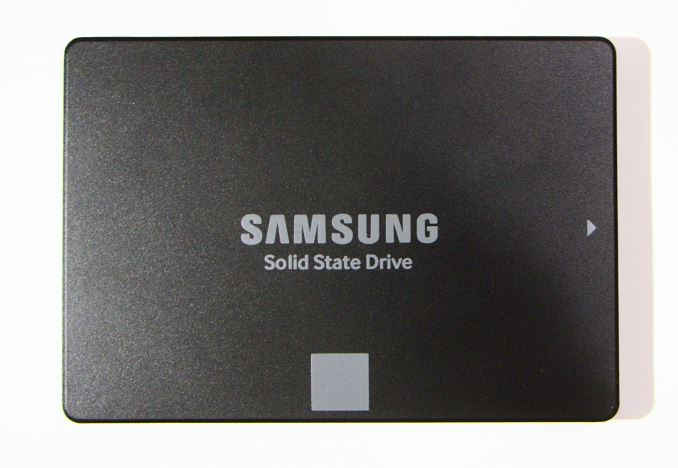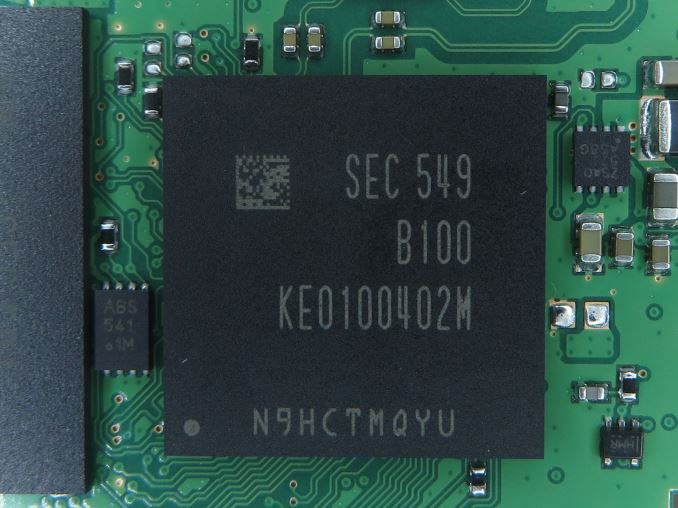The Samsung 750 EVO (120GB & 250GB) SSD Review: A Return To Planar NAND
by Billy Tallis on April 22, 2016 8:00 AM EST
Since the introduction of their first consumer TLC SSD with the SSD 840, Samsung's consumer/retail SATA SSD lineup has consisted of two product families: the MLC-based Pro drives, and the TLC-based 840 and EVO drives. The strength of Samsung's SSD controllers and the advantages of 3D NAND have allowed the 850 EVO to maintain a solidly mid-range position in the SSD market well above any other drive using TLC NAND.
Meanwhile, with the strength of the 850 EVO as a near-midrange product - and with pricing to match - like so many other vendors over the last year, Samsung has also been developing a true low cost TLC drive for the mass market. The end result is the Samsung 750 EVO, which we're revieiwng today. The 750 EVO establishes a new budget-oriented product line that competes in the cutthroat low end of the market where price per GB is the most important aspect of the product.
There are several design choices that help minimize the cost of the 750 EVO, aside from the obvious choice of TLC over MLC. The MGX controller it borrows from the lower capacity 850 EVOs is a dual-core version of Samsung's usual triple-core architecture. Similarly, the 750 EVO is only available in 120GB and 250GB sizes, so there is no high-priced high capacity model. Consequently, with only two small capacities, the 750 EVO line is served by a single tiny PCB layout, made even smaller by the fact that Samsung has put the 256MB of DRAM in the same package as the SSD controller.

Samsung MGX controller with onboard 256MB DRAM
But the most significant aspect of the 750 EVO is that it doesn't use the 3D NAND that has been a key competitive advantage for Samsung's 850 product lines. Samsung has continued development of planar NAND even after transitioning their retail SSDs to 3D NAND, and the 750 EVO in turn uses 16nm planar TLC. It doesn't offer the same performance or endurance of Samsung's 3D NAND, but it does significantly lower the cost of the drive.

128GB of 16nm TLC NAND in a single package
The 16nm TLC NAND is the successor to Samsung's 19nm TLC that had a troubled tenure in the 840 EVO. With the 840 EVO, data at rest on the drive degraded over time and eventually required the use of more thorough and thus slower error correction when read back. As a result the 750 EVO inherits the benefits of all the firmware work Samsung did to mitigate the read speed degradation. This, for what it's worth, gives Samsung some degree of a leg-up against other 16/15nm TLC drives that face the same challenges.
| Samsung TLC SATA SSD Comparison | |||||
| Drive | 750 EVO 120GB | 750 EVO 250GB | 850 EVO 120GB | 850 EVO 250GB | |
| Controller | MGX | MGX | |||
| NAND | Samsung 128Gb 16nm TLC | Samsung 32-layer 128Gbit TLC V-NAND | |||
| DRAM | 256MB | 256MB | 256MB | 512MB | |
| Sequential Read | 540MB/s | 540MB/s | 540MB/s | 540MB/s | |
| Sequential Write | 520MB/s | 520MB/s | 520MB/s | 520MB/s | |
| 4KB Random Read | 94K IOPS | 97K IOPS | 94K IOPS | 97K IOPS | |
| 4KB Random Write | 88K IOPS | 88K IOPS | 88K IOPS | 88K IOPS | |
| 4KB Random Read QD1 | 10K IOPS | 10K IOPS | 10K IOPS | 10K IOPS | |
| 4KB Random Write QD1 | 35K IOPS | 35K IOPS | 40K IOPS | 40K IOPS | |
| DevSleep Power | 6mW | 2mW | |||
| Slumber Power | 50mW | 50mW | |||
| Active Power (Read/Write) | 2.1W / 2.4W (Average) | 2.4W / 2.8W (Average) | Max 3.7W / 4.4W | ||
| Encryption | AES-256, TCG Opal 2.0, IEEE-1667 (eDrive) | AES-256, TCG Opal 2.0, IEEE-1667 (eDrive) | |||
| Endurance | 35TB | 70TB | 75TB | ||
| Warranty | Three years | Five years | |||
By and large the performance specifications for the 750 EVO match the lower capacity 850 EVO, though a slightly lower random write speed at a queue depth of one hints that the 750 EVO may require a bit more background wear leveling work. The feature set is identical to the 850 EVO, making the 750 EVO one of the few low-end drives to support TCG Opal encryption.
Samsung's marketing strategy for the 750 EVO is a little different from their previous retail SSD products. The 750 EVO is targeted specifically at system integrators and system builders, rather than at users looking to upgrade an existing machine. Consequently, they aren't pushing to make the 750 EVO available from as wide a range of retail outlets. Enough of the major online retailers have it in stock that it is not difficult to obtain.
This review will focus on comparing the 750 EVO against Samsung's other SATA SSDs and against other current-generation low-end TLC SSDs of comparable capacity. Our Bench tool can assist in making other comparisons.
| AnandTech 2015 SSD Test System | |
| CPU | Intel Core i7-4770K running at 3.5GHz (Turbo & EIST enabled, C-states disabled) |
| Motherboard | ASUS Z97 Pro (BIOS 2701) |
| Chipset | Intel Z97 |
| Memory | Corsair Vengeance DDR3-1866 2x8GB (9-10-9-27 2T) |
| Graphics | Intel HD Graphics 4600 |
| Desktop Resolution | 1920 x 1200 |
| OS | Windows 8.1 x64 |
- Thanks to Intel for the Core i7-4770K CPU
- Thanks to ASUS for the Z97 Deluxe motherboard
- Thanks to Corsair for the Vengeance 16GB DDR3-1866 DRAM kit, RM750 power supply, Carbide 200R case, and Hydro H60 CPU cooler










109 Comments
View All Comments
DanNeely - Friday, April 22, 2016 - link
The cheap SSD will still blow the spinning rust in the other crappy TN 720p laptop out of the water.jabber - Friday, April 22, 2016 - link
Yeah amazing how limited people's imaginations are when it comes to hardware and other peoples usage needs. Unless it's pushing 2GBps it's junk. Tedious people. If every laptop in the world with a cheap 5400rpm HDD in it swapped to one of these 'bottom of the barrel' Samsung SSDs, it would be a revelation. Make my job of support a lot easier and faster.Movieman420 - Friday, April 22, 2016 - link
Keep in mind, launch prices are always a bit high. Sammy could sell em for less at retail...but they're really not after retail with the 750...they wanna move em in bulk minus retail packaging costs. As far as performace, they're just right...for the intended market. As a budget OEM part, the vast majority of end users (80% maybe?) will fall in Anands light bench metric where this drive makes a pretty good showing. Any better would risk cannibalizing EVO sales. Overall, this product and placement was well thought out by Samsung...as usual....and from a performance standpoint a lil over-provisioning goes a long way. I'm assuming it's not compatible with magician's RAPID mode...unless say your a huge oem customer who'd pay a tad extra and make it a performance offering in more expensive lappys with enuff ram.
iwod - Friday, April 22, 2016 - link
What we need to know is final street price, not launch price.Because as it stand i have Zero reason to buy them. It needs at least a 50% price cost.versesuvius - Saturday, April 23, 2016 - link
As long as Samsung is clearing unused chips from its stock, it could just offer these drives for $25 each to make a gesture of good will towards its existing customers and make some new ones too.The_Assimilator - Saturday, April 23, 2016 - link
Good to see you're "revieiwng" this drive. Could you maybe consider reviewing a spellchecker and/or editor in future?zodiacfml - Saturday, April 23, 2016 - link
Cheapest option but purchased separately, $10 difference is not worth it.The perrformance of the 850 is useful for most people savvy enough to replace drtives.
serendip - Saturday, April 23, 2016 - link
$10 may be a big BOM savings for large system builders but it's pocket change for consumers looking to upgrade from a hard drive. This drive probably isn't aimed at you :)I wouldn't trade $10 for half the write longevity and potentially other issues from using planar TLC. The 850 Evo is still the king and the Sandisk Ultra II is also a good deal when it goes on sale.
Peroxyde - Sunday, April 24, 2016 - link
How is the Corsair LE compared to 850 EVO, 750 EVO? In terms of reliability?odedia - Sunday, April 24, 2016 - link
According to Amazon.com, this drive is currently more expensive then the 250gb 850 Evo. Makes zero sense to buy this today. maybe in a year it will be priced accordingly.